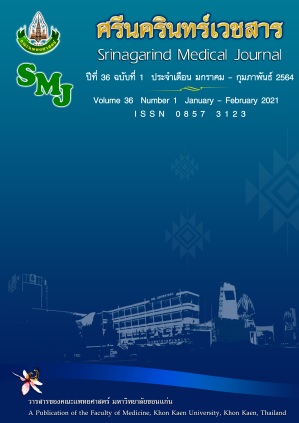Effect of Quality Improvement in Medical Devices Preparation on IncreasingCustomers’ Satisfaction in Services of the Central Sterile Supply Department,Srinagarind Hospital, Faculty of Medicine, Khon Kaen University
Keywords:
Quality improvement, Preparation of medical devices, CSSD, Satisfaction.Abstract
Background and Objective: Preparation of medical devices from CSSD for use in hospital services requires quality and readiness for use. A guideline for good practice is necessary for safety, assurance, and maximum customer satisfaction, and to accommodate effective healthcare services. The objective of this research is to improve and develop medical device preparation guidelines to satisfy clients.
Methods: This action research was based on the concepts of Kaizen and ECRS. The research was conducted in three phases, which were: 1) study, problem analysis and planning for improving the preparation of medical devices; improving the quality, planning for implementation of medical device preparation guidelines which the research team adapted and developed, adding inspection categories, training the staff members, holding focus group, improving cleaning processes and stock system; 3) improvement evaluation from (1) quality improvement of medical device preparation and (2)client satisfaction. The research took place from January to December 2019.
Results: The monthly percentages of medical equipment passing quality criteria before and after the implementation plan were 91.82±1.19% and 95.33±1.25% (p ≤ 0.005). Average client satisfaction score increased from 76.80% to 83.40% (p = 0.006).
Conclusion: The implementation of Kaizen and ECRS principles for quality improvement successfully increased the quality of equipment preparation, improved client satisfaction, and introduced standardized, quality guidelines.
References
ปราศจากเชื้อ; กรุงเทพฯ; 2561.
2. Rutala W, Weber D. Disinfection and sterilization in healthcare facilities. In: Lautenbach E, Malani P, Woeltje K, Han J, Shuman E, Marschall J, Editors. Practical healthcare epidemiology. 4th ed. Cambridge: Cambridge University Press; 2018: 58-81.
3. World Health Organization; Pan American Health Organization. Decontamination and reprocessing of medical devices for health-care facilities.Geneva: WHO Document Production Services; 2016. [cited Dec 5, 2019]. Available from: https://apps.who.int/iris/bitstream/handle/10665/250232/
9789241549851-eng.pdf;jsessionid=EBE22D186CEA3066B6B42C95573C1593?sequence=1
4. Ling ML, Ching P, Widitaputra A, Stewart A, Sirijindadirat N, Thu LTA. APSIC guidelines for disinfection and sterilization of instruments in health care facilities. Antimicrob Resist Infect Control. 2018;7:25. doi:10.1186/s13756-018-0308-2.
5. Cowperthwaite L, Holm RL. Guideline implementation: surgical instrument cleaning. AORN J. 2015; 101: 542-52.
6. Spry C, Conner, RL. Guideline for cleaning and care of surgical instruments. In: AORN, Conner R,
editors. Guidelines for perioperative practice. Denver,AORN; 2017.815–50. พิมพ์ครั้งเดียวค่ะ
7. Greene-Golden, S. The Importance of Following Manufacturers’ IFUs [Internet]. Infection Control
Today. 2019 [cited 2019 Dec 5]. Available from: https://www.infectioncontroltoday.com/view/importance-following-manufacturers-ifus.
8. Fuchs W, Kirmse G, Henn H, Tangel B, Leibinger K, Niebur S, et al. Reprocessing of instruments to retain value. 11th ed. Gütersloh: The Instrument Reprocessing Working Group (AKI); 2017. [cited Dec 5, 2019]. Available from:https://pcosmidis.gr/index.php?controller=attachment&id_attachment=634.
9. ราตรี นาคกลัด, เปรมฤทัย น้อยหมื่นไวย. การพัฒนาระบบปฏิบัติการทำให้ปราศจากเชื้อโดย
ประยุกต์ใช้แนวคิดลีน โรงพยาบาลสิชล จังหวัดนครศรีธรรมราช. วารสารความปลอดภัยและสุขภาพ. 2561; 11: 59-71.
10. สมภาร วรรณรถ. การเพิ่มประสิทธิภาพการทำงานโดยใช้แนวคิดไคเซ็น กรณีศึกษา บริษัท วาย เอส ภัณฑ์ จำกัด. วารสารเกษมบัณฑิต 2561; ฉบับพิเศษ: 142-159.
11. กิติศักดิ์ พลอยพานิชกุล. TQM : การบริหารเพื่อคุณภาพโดยรวม. พิมพ์ครั้งที่ 1 กรุงเทพฯ: สมาคมส่งเสริมเทคโนโลยี (ไทย-ญี่ปุ่น); 2557.
12. จารุวัฒน์ เนตรนิ่ม. การปรับปรุงกระบวนการการบริหารสินค้าคงคลังโดยใช้ทฤษฎีไคเซ็น กรณีศึกษา: คลังเครื่องแต่งกาย กรมยุทธบริการทหาร กองบัญชาการกองทัพไทย. วารสารสถาบันวิชาการป้องกันประเทศ 2560; 8: 96-110.




